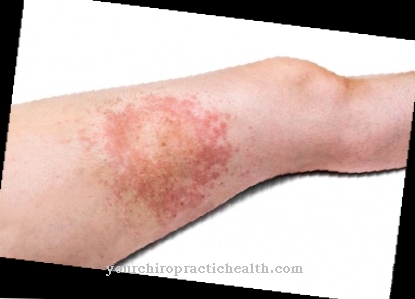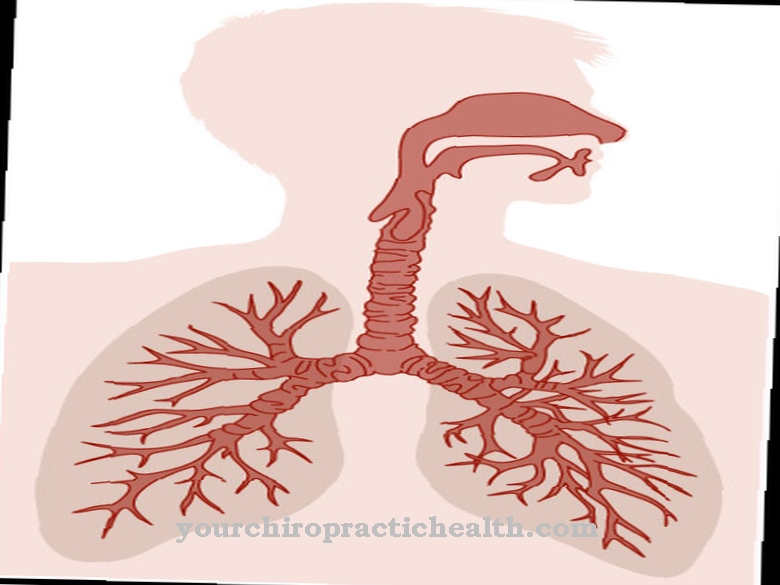A Heavy metal poisoning can be caused by different metals and characterized by an acute or a chronic course.
What is Heavy Metal Poisoning

© Tanapat Lek, jew - stock.adobe.com
In the Heavy metal poisoning toxic metals have penetrated the organism, which have a different poisoning effect. In principle, heavy metal poisoning can cause damage to the organism by integrating it into the metabolism.
Some metals such as arsenic, nickel, zinc, iron and copper are vital for the organism in low doses. However, if their concentration increases, heavy metal poisoning occurs. Other heavy metals such as lead, cadmium, mercury or aluminum (light metal) can immediately lead to heavy metal poisoning as soon as they are ingested in small quantities.
Heavy metal poisoning is not just an inherent damage to health. They are often the trigger for other diseases that arise from the symptoms of poisoning. Heavy metal poisoning can be treated supportively by means of special drainage methods. Heavy metal poisoning can occur in adults and children.
causes
The causes of the Heavy metal poisoning are quite diverse. In medicine, a distinction is made between various complexes of causes.
In addition to the direct ingestion of the heavy metal through food, as can be the case, for example, when eating mushrooms or drinking water enriched with lead, it is possible that the toxic substances accumulate, which can lead to heavy metal poisoning.
In addition, people ingest the toxic heavy metals not only through food, but also through polluted air in the form of exhaust gases. Another cause of heavy metal poisoning can be metal implants, which are mainly known from dentistry as amalgam fillings.
Over the years, this leads to a deposition of mercury, which is deposited in special organs and causes heavy metal poisoning.
Symptoms, ailments & signs
Heavy metal poisoning can make itself felt through a variety of complaints, the symptoms mainly depend on the type and concentration of the toxic substance ingested. Signs of acute lead poisoning can be severe abdominal cramps, headaches and aching limbs, as well as fatigue; the chronic form is noticeable as lead anemia associated with fatigue and decreased performance, as well as heart problems.
A blue-gray lead border on the gums is typical, damage to the nervous system can manifest itself through insomnia, overactivity, disorientation and sensory disturbances in the extremities. In severe cases it can lead to life-threatening cardiovascular failure.
Acute mercury poisoning occurs very rarely, with chronic mercury poisoning, unspecific symptoms such as fatigue, headaches, inflammation of the gums and diarrhea occur initially. In the further course, muscle twitching, states of fear and excitement, impairment of hearing, vision and speech as well as motor impairments, concentration disorders and personality changes can occur.
Cadmium poisoning can result in pneumonia, but also kidney weakness, an increased tendency to form urinary stones or emphysema. Other unspecific symptoms that can occur in the event of heavy metal poisoning are skin changes such as eczema or discoloration, tremors, symptoms of paralysis and abdominal pain. Liver and kidney damage often only becomes noticeable at an advanced stage in the form of yellowing of the skin and greatly increased or decreased urine output.
Diagnosis & course
As already described, the Heavy metal poisoning take an acute or sudden course. However, there is also heavy metal poisoning that is insidious and the symptoms of which keep recurring. It always depends on the type of poisoning and the amount of heavy metal ingested.
In order to be able to precisely demonstrate heavy metal poisoning, innovative diagnostic methods and procedures are used in modern medicine. Those affected, who feel physically unwell, suffer from symptoms such as discoloration of the skin, tongue and nails or nausea and other complaints, first contact a specialist.
Since the symptoms that occur with heavy metal poisoning can be extremely protracted and sometimes quite unspecific, frequent misdiagnoses cannot be ruled out. Therefore, an exact diagnosis of heavy metal poisoning is not always easy to make.
Complications
If there is heavy metal poisoning, this initially manifests itself in impaired consciousness (increased drowsiness and severe tiredness) and a noticeable skin rash. If left untreated, these symptoms will intensify over the course of days, weeks, or even years and cause serious complications. Often, the initial difficulty concentrating develop into serious psychological conditions such as anxiety disorders and hyperactivity.
Memory loss can also occur. Other complications are cardiac arrhythmias and fluctuations in blood pressure, which in extreme cases can lead to heart attacks. Heavy metal poisoning can also cause allergies and gastrointestinal diseases. Treatment of heavy metal poisoning usually proceeds without major complications. However, the prescribed drugs can cause side effects and occasionally trigger allergic reactions.
The commonly used medicinal charcoal leads in rare cases to constipation and intestinal obstruction. A harmless complication is the typical black color of the stool. If a gastric lavage is performed, it can cause shortness of breath, pneumonia and internal injuries. Overall, blood washing is a major psychological and physical burden for the patient. Regular dialysis can also promote heart disease and damage to the vessels and joints.
When should you go to the doctor?
In the event of heavy metal poisoning, a doctor must always be consulted immediately. Only through a quick diagnosis and treatment can further complications and complaints be prevented, which in the worst case can reduce the life expectancy of the person affected. A doctor should be consulted if the person concerned has ingested a high amount of heavy metals. This usually leads to severe pain in the stomach and limbs, which can also lead to severe tiredness and exhaustion. If these complaints occur, a doctor must be consulted immediately.
Heart problems can also indicate heavy metal poisoning. Those affected also continue to suffer from inflammation all over the body, often with severe tremors. In the event of heavy metal poisoning, a hospital must be visited immediately or an emergency doctor called. Further treatment depends heavily on the amount ingested and on the doctor of the heavy metal. In some cases, the life expectancy of those affected by heavy metal poisoning is reduced if treatment is started late.
Treatment & Therapy
Treatment of Heavy metal poisoning not only has a high priority in conventional medicine. Various alternative medical therapy methods can also help alleviate or eliminate the triggers and symptoms.
One of the currently practiced forms of therapy that are used in a clear diagnosis of heavy metal poisoning is the so-called chelation treatment. This is based on the binding of heavy metals in the organism by EDTA and DMPS. Chelation therapy is considered an extremely gentle application. The principle of this therapy is based on the targeted removal of heavy metals.
If there are acute signs of heavy metal poisoning, rapid treatment is essential to stabilize the function of all vital organs. In addition to chelation therapy, a number of drugs are prescribed for symptoms of heavy metal poisoning, including oral antidotes and activated charcoal as absorption agents.
In addition, if there is a justified suspicion of heavy metal poisoning, the doctors perform gastric irrigation. In the context of the primary or first possible treatment of heavy metal poisoning, activated carbon is predominantly used.
In the second step, blood washing, a so-called hemoperfusion and lipid therapy can follow. Hemoperfusion is similar to dialysis; in contrast to blood washing or hemodialysis, the blood passes through a filter system made of activated carbon.
prevention
Around Heavy metal poisoning To prevent this, the intake of toxic substances should of course be avoided. In addition, it is advantageous to eliminate amalgam fillings with other substitutes.The consumption of a lot of water without pollutants also makes sense. At workplaces with a high content of heavy metals, appropriate industrial safety measures must be taken so that these substances cannot get into the organism.
Aftercare
Depending on the severity of the poisoning, the patient's body is permanently damaged even after the heavy metals have been successfully removed. During follow-up care, he should focus on the one hand on avoiding exposure to heavy metals in the future and on careful handling of his weakened body on the other. It is important to know how heavy metal poisoning came about.
This is the only way to avoid it in the future. Sometimes it is enough for patients to have their amalgam fillings replaced, but sometimes they have to consider moving to less polluted areas. Patients should definitely follow the recommendation to drink plenty of clear, unpolluted water for a lifetime.
So even the smallest amounts of toxins can be flushed out. At the same time, you should avoid anything that unnecessarily weakens your body. These include poisons such as nicotine and alcohol, but also harmful foods such as cheap meat and fruits and vegetables from uncontrolled cultivation.
Gentle detoxification measures, such as regular visits to the sauna or steam bath, are also advisable. Even sweaty exercise detoxifies the body. Fruits and vegetables rich in water such as melon or cucumber support the detoxification process. Then the patient should allow himself and his body a lot of restful rest.
You can do that yourself
Patients can do a lot at home to gradually remove toxins and heavy metals from their bodies. This includes everything that makes the body sweat, sport as well as sauna or steam bath visits.
There is also the option to detox in the bathtub at home. To do this, the patient takes a hot full bath every two days for six weeks in which 300 grams of magnesium chloride or Epsom salt (magnesium sulfate, Epsom salt) has been dissolved. No other bath additives may be added. The patient should bathe for twenty to thirty minutes at a temperature of 37 to 39 degrees Celsius. Then do not dry off, but lie wet in terry towels and sweat out the toxins for another half an hour. They are neutralized on the body by the magnesium salts. Both magnesium chloride and Epsom salt are available over the counter in pharmacies.
The ingestion of coarse-grained healing clay or zeolite also has a detoxifying effect. The administration of turmeric also accelerates the elimination of heavy metals in the body. However, it is not enough to season with turmeric. Instead, patients should take a dietary supplement that also contains black pepper. Black pepper significantly increases the bioavailability of turmeric.
While the patient is actively detoxifying, he should allow himself a lot of rest and avoid consumption poisons such as alcohol and nicotine.



.jpg)
.jpg)
.jpg)






















.jpg)